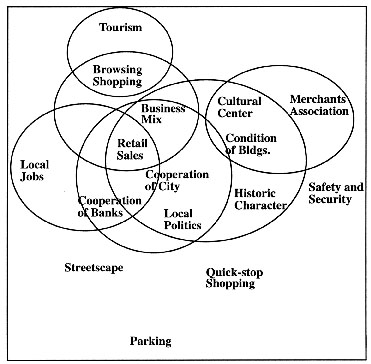
Development of an evaluative tool is an important need for city planners, local officials, downtown business owners, and others concerned about the effectiveness of downtown revitalization efforts. The hypothesis of this study is that such a tool can be created. The Health Perception Index (HPI), as described and utilized throughout this study, provides a base Index evaluation against which other factors may be compared. It can be used as a yardstick for evaluating revitalization efforts. It is multi-dimensional, and can be utilized both in different communities and at varying time periods.
The study investigated attempts made by business and community leaders to revitalize their downtowns, and evaluated the relative success of these efforts. In addition to evaluating the business environments of these downtowns, their role as social and cultural centers of their communities was also examined.
A Diverse Market. Downtown must have a mixture of complementary uses in a concentrated area to generate the pedestrian activity that creates a lively, interesting social environment and a profitable business setting.In the Tyler study, functional characteristics were found more central to success, even though more money and attention had been paid to physical factors. Both types of improvements are important, but physical improvements are more a reflection of good health, rather than the cause of it, while functional factors were more causal.A Quality Place. Downtown must have a physical setting for pedestrian activity that is comfortable, convenient, visually interesting, and secure." 2
Of the characteristics considered, it was found that "Business mix" was the characteristic most closely correlated to the Health Perception Index (HPI). In other words, the factor having the closest association with perceived downtown health was shown to be the types of businesses located there.
This is supported through the work of Hyett-Palma, who have found,
In the past, Downtown leaders often thought that the way to compete with malls was to create a physical "theme" that would make Downtown distinct. The more current thinking is that--to stand out in the mind of the customer--Downtown must create and market economic themes. These are created by clustering together businesses--such as apparel or antiques or restaurants or home furnishings, etc.--that appeal to a particular customer group. By clustering similar businesses near each other, these businesses become more convenient for customers and Downtown becomes known for these businesses. In this way, Downtown takes on an economic "theme" that makes it distinct.If business mix is important to downtown health, then what makes up a good mix? A good business mix includes various types of businesses, but the business type having the strongest correlation with the Health Perception Index was "Browsing shopping." 3 Browsing shopping represents businesses that encourage shoppers to stay longer and comparison shop, and relies on complementarity of stores in close proximity. Representative browsing shopping businesses include gift shops, antiques stores, book shops, bakeries, etc.
Other downtown characteristics which were shown to be closely correlated to the HPI included "Retail sales" and "Cooperation of city government." Most of the other sixteen downtown characteristics had varying degrees of correlation with the HPI.
The following chart illustrates clearly and simply the downtown characteristics that are central to perceived downtown health, as well as their relationships to each other.

As shown in the chart above, three factors had virtually no correlation with downtown health--"Streetscape improvements," "Parking," and "Quick-stop shopping." This was a surprising conclusion, for revitalization programs often include all three of these characteristics as major factors in their efforts. Yet the three were shown to be not that important for varying reasons. Streetscape improvements were sometimes seen as important, and sometimes not.
Streetscape improvements, such as sidewalk pavers, trees and benches, and new lighting, have commonly been viewed as a panacea for poor downtown health. The study indicates that such improvements play only a minor role. Physical improvements should be seen as a product of improved downtown health, rather than a cause of it. As is suggested by the old cliche, "Beauty is only skin deep."
Possibly more surprising and controversial was the finding that convenient parking was the characteristic least correlated with the downtown health index. Many merchant associations have expressed their concern with the inadequacy of downtown parking as a reason for their poor sales, and city officials have responded by spending capital improvements money on larger parking lots. Yet this survey found that other factors were much more closely tied with commercial success, and that parking was largely overrated as a factor. This is important to recognize, because many cities have allocated a large portion of their downtown improvement budget to more or improved parking, when there is no evidence that the amount or quality of parking contributes to downtown health in any significant way.
The third non-factor was what was labelled quick-stop shopping--the type of shopping that imitates the strip commercial centers. Customers typically have directed purchases, with their goal to be quickly in and out. These types of businesses do not contribute to the character of healthy downtowns, which are most successful when they are destination points, rather than quick stops along the way to somewhere else.
1 Inland Architect. July/August 1989. p. 51.
2 Cyril Panmier. Designing the Successful Downtown. p. 3.
3 This supports the conclusion of a precursor 1986 study, which found a strong association between "Browsing shopping" and the study's Health Index.
| Revitalization Strategies | Review of Revitalization Strategies |
|---|
| The Need for More Study |
|---|
